Coventry Electric Tramways
History
The story of Coventry Electric Tramways starts with the failure of its operational predecessor, the much-troubled Coventry and District Tramways Company, the owner and operator of a 5.75-mile steam tramway plying between Coventry and Bedworth. The C&DTCo was hamstrung with poor finances throughout its life (1884 to 1893), finally being seized by its debenture holders in 1892, who then appointed a receiver. The latter sold the concern to W Graff Baker (in summer 1892), an electrical engineer who had been intimately involved with the first overhead electric tramway in the British Isles (the Roundhay Electric Tramway in Leeds), and who had close connections to the US Thomson-Houston Company and its successor, General Electric. Graff Baker soon commenced negotiations with Coventry Corporation to convert the existing line to overhead electric traction, which unusually could apparently be done under the existing powers that were used to build the steam tramway. At the same time, he also endeavoured to keep some sort of service running with the steam trams, though by late 1892, problems with the engines had reached such a head that it was impossible to carry on, services eventually ceasing, probably on or just before the 1st January 1893 when Board of Trade approval for the use of steam traction is believed to have expired.
This was still very early days for overhead electric traction, and negotiations with the corporation dragged on, the latter no doubt wanting all sorts of assurances given its experiences with the Coventry and District Tramways Company. Although these impositions at times threatened to sink the scheme, work finally commenced on converting the 3ft 6ins-gauge steam tramway in early summer 1895, the first electric service running from Coventry to Foleshill on the 4th December 1895, and right through to Bedworth one week later.
It is unclear who Graff Baker's backers were, or who the main investors were in the company that was set up to build and operate the tramway — Coventry Electric Tramways Limited — which was registered in 1893. In 1897, however, a new company — the Coventry Electric Tramways Company — was incorporated by an act of parliament (on the 6th August 1897) to acquire Coventry Electric Tramways Limited, and raise the capital necessary for expansion. The new company was controlled by the New General Traction Company, which already owned Douglas Southern Electric Tramways (opened in 1896), and which would go on to open Norwich Electric Tramways in 1900. The same act also empowered the new company to build three extensions, to Bell Green via Priestleys Bridge, and to Stoke via Hales Street, with two loops (one running north and one running south) converging at Gosford Green. The Stoke route via the southern loop was opened on the 22nd July 1899, with the northern loop opening 3 days later on the 25th July 1899; the Bell Green line was also opened on the 22nd July 1899, but only as far as Priestleys Bridge, the full extension to Bell Green opening on the 18th January 1900.
Even at this time, the company was clearly nervous about any potential municipalisation, only proceeding with the above expenditure in exchange for a commitment from the corporation to defer its 'right to buy' beyond the usual 21 years.
A further act of parliament was passed on the 14th August 1903, which authorised further extensions, principally to Earlsdon and Allesley Road. These were opened on the 22nd March 1905, taking the system to its final size under the company of 13.16 miles. From the city centre (Broadgate), lines radiated: southwards to Coventry Station; westwards along Spon Street to Allesley Road, where the terminus was situated opposite Mount Street, with a branch leading off southwestwards to a terminus opposite St Barbara's Church in Earlsdon; and northwards via Bishops Street, Foleshill and Longford to a terminus in Bedworth High Street. A network of lines also branched off from Bishop Street eastwards along Hales Street, whereupon they divided into three: one line heading northeastwards via Stoney Stanton Road to a terminus opposite Henry Road in Bell Green; and the others heading to the Bulls Head in Stoke, one via Ford Street and Lower Gosford Street (the southern loop), and the other via White Street and Paynes Lane (the northern loop), after which they rejoined one another at Gosford Green.
The system was eventually worked by 41 tramcars, 6 of them having been converted from Falcon steam-tram trailers.
Unlike the steam tramway, the electric tramway was a financial success, profits rising from £3,360 in 1903 to £12,599 in 1912. The profitably of the system seems to have attracted the attention of the corporation, the latter having succeeded in having a 'right to buy' clause inserted into the 1903 legislation; this gave the corporation the right to purchase the tramway as a going concern after seven years, and at seven-year intervals thereafter. Although the first of these milestones was not until 1910, this no doubt coloured the company's thinking around investment, on which it could not guarantee to make a return.
In 1910, the corporation commissioned a survey of the tramway from the General Manager of Birmingham Corporation Tramways, Alfred Baker. Although Mr Baker noted that the tramcar fleet was old, and that various other aspects of the tramway's infrastructure were in need of investment, he still felt that the price the corporation would have to pay would inevitably give rise to a charge on the rates. Despite the warning, which was to prove prophetic, the corporation pressed on with the purchase, which ended up in arbitration, the two sides presumably being unable to agree a price. The corporation eventually had to pay £220,638 for the privilege of owning the tramway, taking possession of its new asset on the 1st January 1912.
Uniforms
Motormen and conductors were issued with double-breasted jackets with three pairs of buttons, three waist-level pockets (with flap closures), an open breast pocket, and lapels; neither the lapels nor the collars appear to have borne any insignia. Caps were in a kepi style with a glossy peak, and carried — at least from around the turn of the century, and possibly from the inauguration of electric services — a large oval cap badge. All that can be said with certainty is that the badge comprised a tall oval topped by a small protuberance. The general form of the badge is strikingly similar to that used by the CETCo's sister company, the Norwich Electric Tramways Company, which comprised a horizontal oval (bearing the full company title and an employee number), surmounted by a lion (see link). It therefore seems reasonable to suggest that the CETCo cap badge may possibly also have borne the full company title and an employee number. Unfortunately, no examples of the cap badge are known to have survived.
Later in the company's existence, and before it was taken over by Coventry Corporation in 1912, the kepi-style caps were superseded by tensioned-crown peaked caps; these continued to bear the distinctive oval cap badge, and in summer, were worn with white rain covers.
Tramcar crews were also issued with long, double-breasted greatcoats with four pairs of buttons and lapels; the collars, like the jackets, appear to have been devoid of insignia.
The company also operated a postal service, though whether this involved the use of company employees, e.g., messenger or parcels boys, remains unknown.
It is unclear what uniforms were worn by inspectors, as photographic evidence is completely lacking.
Further reading
For a brief historical account of the tramways of Coventry, see 'Coventry Transport 1884-1940' by A S Denton and F P Groves (Birmingham Transport Historical Group; 1985).
Images
Motormen and conductors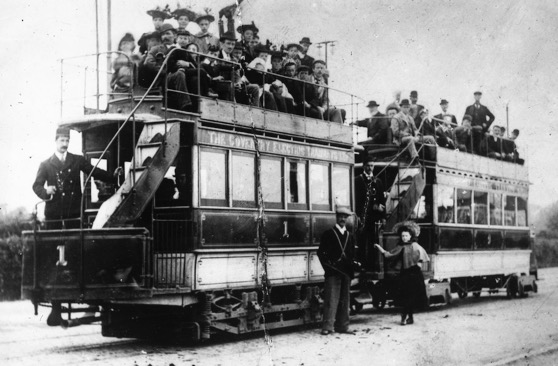
Tramcar No 1 and Trailer No 9 pictured at Foleshill Road — photo undated, but probably taken in 1895 or 1896, and certainly no later than 1898/9 when the latter vehicle was electrified. With thanks to the National Tramway Museum.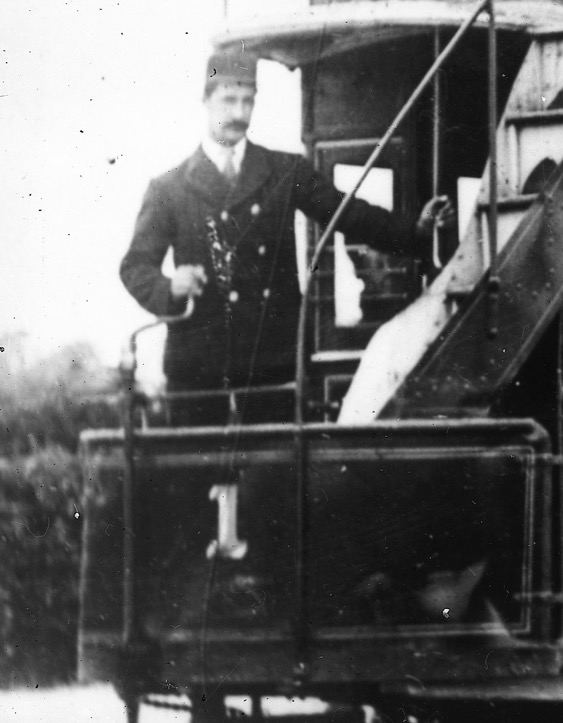
An enlargement of the above photograph showing the motorman, who is wearing a double-breasted jacket and a kepi-style cap, the latter seemingly without a badge, though the photo is too indistinct to state this with any degree of certainty.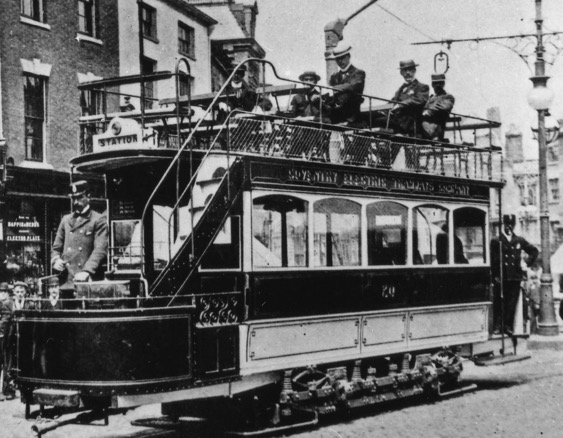
Tramcar No 20 leaving Broadgate in 1899. The motorman is wearing a kepi-style cap that clearly bears a prominent oval cap badge. Photo courtesy of the Tramways and Light Railway Society, with thanks to David Voice.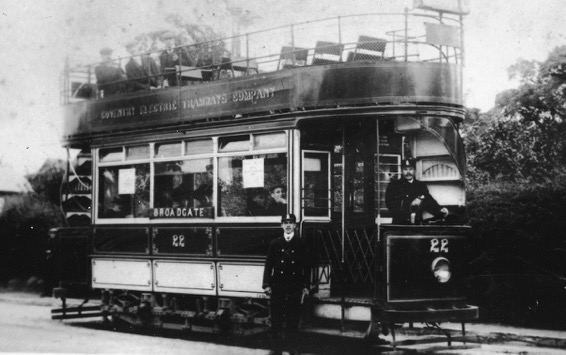
The crew of Tramcar No 22 pose for the cameraman — photo undated, but given the pristine condition of the vehicle, probably taken in the year it was delivered, 1904. With thanks to the National Tramway Museum.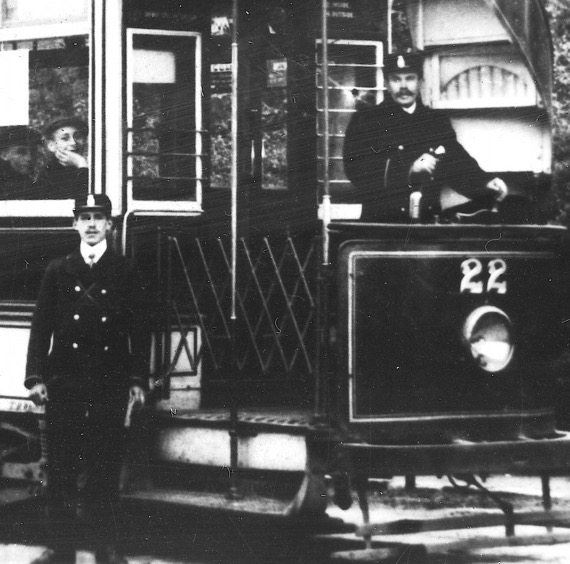
An enlargement of the above photograph showing the crew.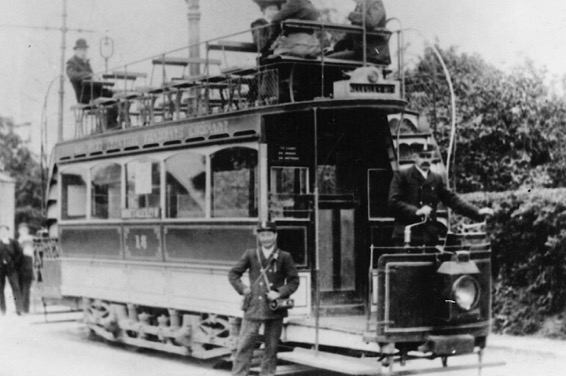
The crew of Tramcar No 18 captured at the terminus at Bell Green around 1905. The conductor is Ernie Parnell. Both men are wearing double-breasted jackets and kepi-style caps, the latter bearing a prominent oval cap badge. Photo courtesy of the Tramways and Light Railway Society, with thanks to David Voice.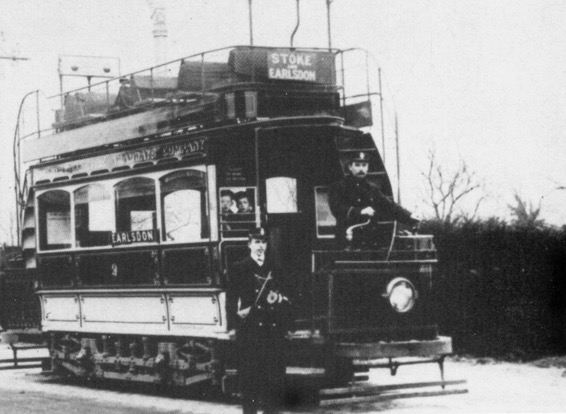
A motorman and conductor with Tramcar No 9 in Binley Road, Lower Stoke — photo undated, but certainly taken no earlier than March 1905 when the line to Earlsdon opened. Both men are wearing greatcoats, along with kepi-style caps. Photo courtesy of the Tramways and Light Railway Society, with thanks to David Voice.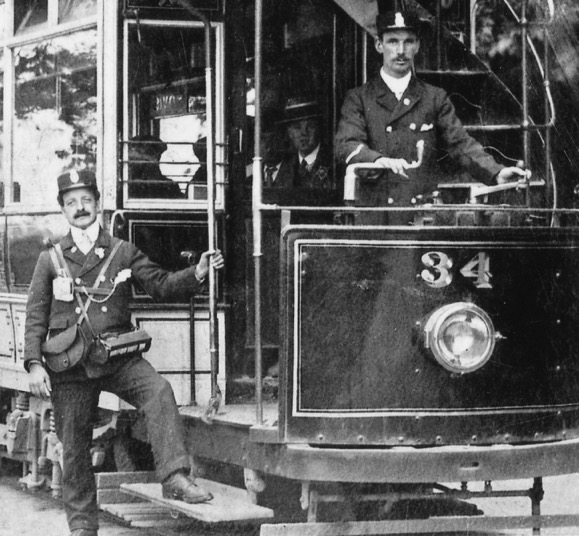
A conductor and a motorman pose on the platform of Tramcar No 34 — photo undated, but certainly taken no earlier than 1907, when this vehicle was delivered. Photo reproduced with the kind permission of Mr T Wilson of Travel Lens Photographic.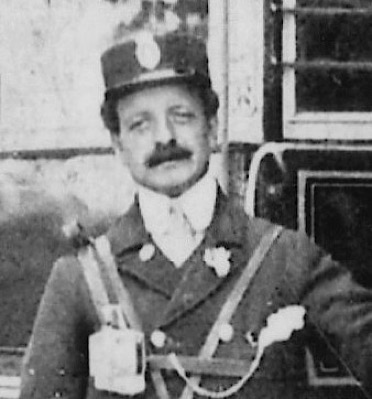
An enlargement of the above photograph showing the conductor's uniform and cap badge; the latter clearly takes the form of a tall oval with a protuberance at the top.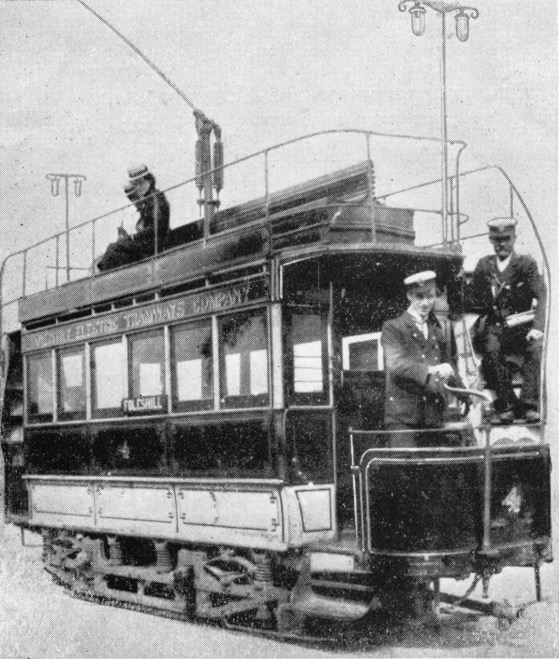
A motorman and a conductor with one of the four original tramcars (No 4) — photo undated, but probably taken in the late-Edwardian era. Both men are wearing tensioned-crowned peaked caps with white rain covers, though with the earlier badge still clearly in evidence. Photo courtesy of the Tramways and Light Railway Society, with thanks to David Voice.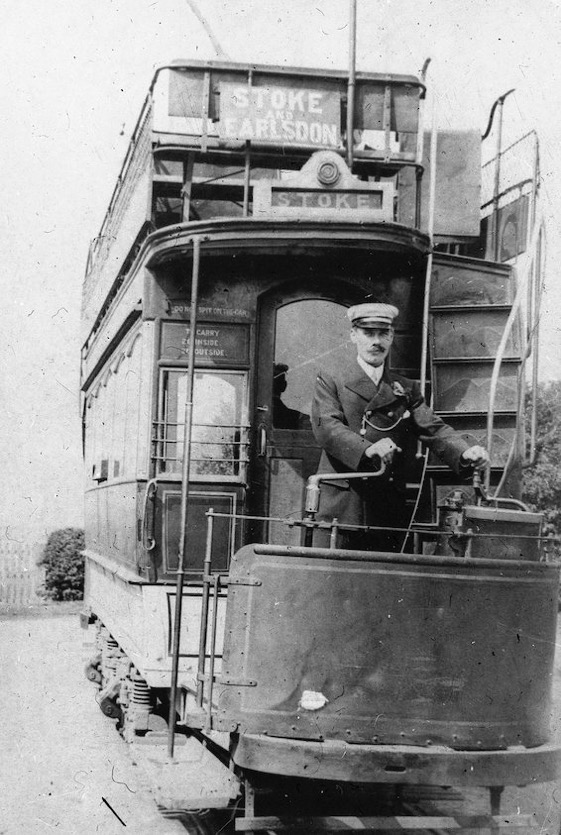
A CETCo motorman at the controls of what is probably one of the No 11-20 series of 1898/9 — photo undated, but judging by the rather lop-sided dash and general air of neglect, probably taken shortly before or shortly after the corporation take-over of 1912. With thanks to the National Tramway Museum. 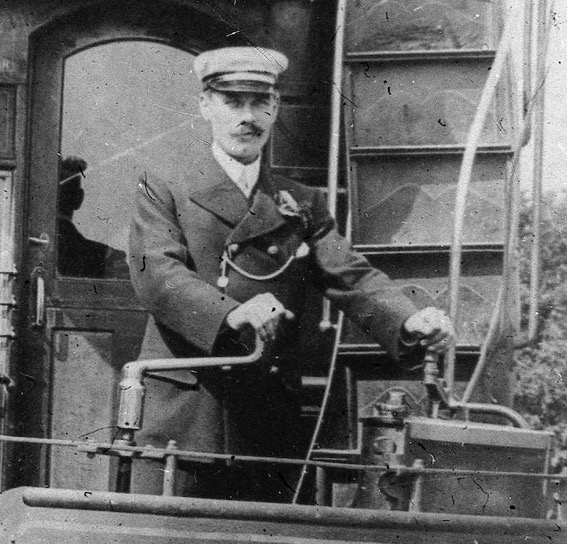
An enlargement of the above photograph showing details of the uniform, which in contrast to the tram, appears to be pristine, and totally devoid of insignia. Although no cap badge is in evidence, this could either be because it is covered by the white rain cover, or because the photo post-dates the corporation take-over.